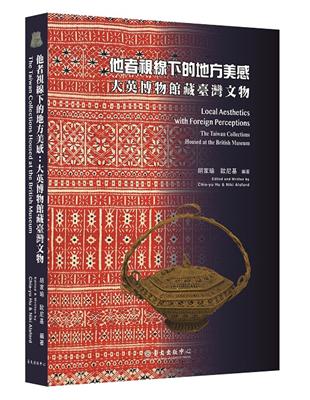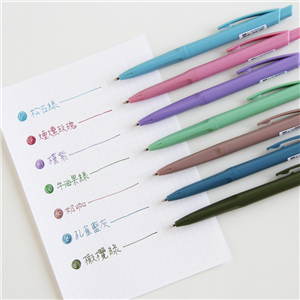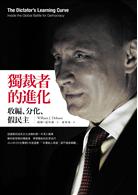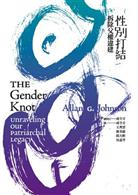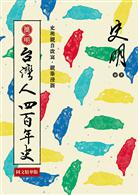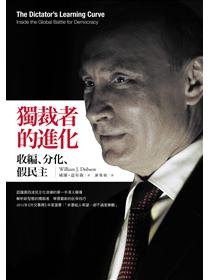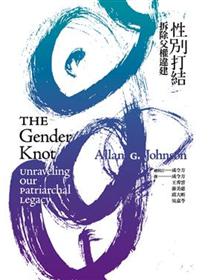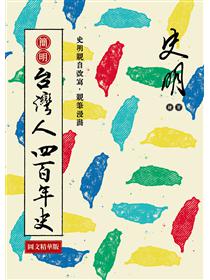精選大英博物館館藏臺灣文物,理解多元文化與歷史意義背後的脈絡及連結。在舉世聞名的大英博物館中,收藏了大約370件早期臺灣文物,其中絕大多數是原住民的物品。這些藏品難得地留存了珍貴的過去物質生活訊息,也呼應了早期臺灣與西方接觸互動的片段歷史。人類學者胡家瑜教授和歐尼基(Niki Alsford)博士特別精選了其中的165件文物,進行入藏歷史脈絡解說和圖像介紹,期盼這些保存在遙遠他方的文化遺產,與臺灣社會重新連結。
透過本書,讀者不僅可以一窺他者目光凝視下臺灣多元文化的精彩和美麗,感受到其中蘊含的文化價值和力量,也能掌握跨文化採集背後複雜交錯的歷史脈絡和動力,進一歩思考文化遺產如何在當代社會活化應用的課題。
作者簡介:
胡家瑜
臺灣大學人類學系教授退休後,現為該系兼任教授。她在英國倫敦大學大學院取得人類學博士學位。多年來從事物質文化、博物館人類學和文化遺產相關教學研究工作,並且長期參與臺灣民族學藏品和原住民物質文化調查研究,以及相關成果的當代應用與活化發展。主要著作包括《賽夏族的物質文化》(1996)、《臺大人類學系伊能藏品研究》(1998)、《道卡斯新港社古文書》(1999)、《針線下的繽紛―大武壠平埔衣飾與刺繡藏品圖錄》(2014)、《賽夏族》(2015)、《文物、造型與臺灣原住民藝術―臺大人類學博物館宮川次郎藏品研究》(2015)等專書。
Chia-yu Hu is Professor of Anthropology in the Department of Anthropology at National Taiwan University. She acquired her PhD degree from the UCL, University of London. She has engaged in teaching and researching of material culture, museum and heritage issues for a long time. Her main interests are in studying Taiwan ethnological collections and Taiwan indigenous cultures, as well as applying research results for contemporary cultural revitalization. She is the author of Material Cultural of the Saysiyat: Tradition and Transformation (1996), Studies on Ino’s Collection at the Department of Anthropology of National Taiwan University (1998), A Collection of Archival Documents from Taokas Sinkang Village (1999), Treads of Splende: Taivon Pingpu Clothes and Embroidery Collections (2014), The Saysiyat (2015), Artifacts, Forms and Taiwan Indigenous Art: Miyagawa Jiro’s Collection in the Museum of Anthropology at National Taiwan University (2015), etc.
歐尼基(Niki Alsford)
歐尼基博士為英國中央蘭開夏大學語言與國際研究學院、亞洲太平洋研究所副教授,以及韓國國際研究中心主任。他同時也是倫敦大學亞非學院臺灣研究中心的研究員。歐尼基自亞非學院取得東亞現代史博士學位,研究焦點著重於十九世紀晚期至二十世紀初期的臺灣社會史。他近期的著作包括:Transitions to Modernity in Taiwan: The Spirit of 1895 and the Cession of Formosa to Japan (Routledge, 2017)、〈塵封的瑰寶:倫敦大學亞非學院特藏臺灣原住民族檔案〉(2017)、發表於Paul Woods所編輯的The Shaping of Christianity in China (2017)一書的Torn Between Two Worlds: Rev. Shoki Coe, Domesticity, and the Taiwanese Self-Determination Movement,以及與Bernhard Fuehrer 共同發表在Translation Studies 1:1 (2017): 137-182期刊中的Carstairs Douglas (1830-1877) and his Chinese-English Dictionary of the Vernacular or Spoken Language of Amoy (1873)。
Dr. Niki Alsford is Reader in Asia Pacific Studies and Director of the International Institute of Korean Studies. He is also Research Associate at the Centre of Taiwan Studies at SOAS, the University in London. He received his PhD in Modern East Asian History from SOAS and his research is grounded on late-nineteenth and early-twentieth century Taiwan social history. His most recent publications include: Transitions to Modernity in Taiwan: The Spirit of 1895 and the Cession of Formosa to Japan (Routledge, 2017); Buried Treasurers: Taiwan Indigenous Peoples’ Archives Held at the School of Oriental & African Studies, the University of London (2017); Torn Between Two Worlds: Rev. Shoki Coe, Domesticity, and the Taiwanese Self-Determination Movement, a chapter in Paul Woods’s The Shaping of Christianity in China (2017); and Carstairs Douglas (1830-1877) and his Chinese-English Dictionary of the Vernacular or Spoken Language of Amoy (1873), which he co-wrote with Bernhard Fuehrer for Translation Studies 1:1 (2017): 137-182.
各界推薦
名人推薦:
吳密察(國史館館長)
十九世紀中葉以後,因為清國與西洋國家締結開港通商條約的關係,陸續有西洋外交官、傳教士、商人、旅行家、學者來到臺灣。他們基於不同的理由,對於臺灣這個島嶼上的居民(特別是民族學上不同於來自中國之移民的臺灣原住民)、地理、動物、植物等各方面投注了關心。二十世紀前夕,臺灣成為日本帝國的殖民地,此時的日本正在引進西洋的諸種學問,日本的學者因而適時地獲得了一個異民族的研究對象與田野地,殖民政府則基於統治異民族殖民地的現實需要,也對臺灣進行研究。因此,可以說西洋人、日本人於這時候對臺灣進行了可稱為近代意義的第一波研究和田野調查。
十九世紀中葉以後大約半個世紀,西洋人、日本人對於臺灣所進行的研究與田野調查,其成果雖然不免有所偏見,也常止於浮面印象,但他們對於這個島嶼的調查與研究,較諸管治這個島嶼已經超過二百年的中國官員多數偏向行政、治安事相的文獻,卻也對臺灣之現實社會面貌有更為具體、生動的描寫。尤其,他們對於臺灣原住民之物質文化的興趣,更是過去以文字描述為主的清國官員所難以望其項背的。
臺灣大學人類學系胡家瑜教授長年致力於臺灣原住民物質文化研究,她不但將日本殖民地時代臺北帝國大學土俗人種學講座陸續收集的文物整理編目出版成圖錄,讓外界可以了解臺大的文物收藏,還以這些文物為媒介,實質地協助臺灣原住民進行文化復振運動。2000年以後,她還系統性地調查了歐美各大博物館的臺灣藏品,並與這些博物館簽訂協定建置成網站,讓不少原來祕藏於博物館庫房中的臺灣文物終於得以面世。此次,她進一步與英國學人歐尼基博士合作將大英博物館收藏的臺灣文物,編輯成圖錄出版。透過此圖錄,讀者不只可以了解大英博物館這個世界知名的博物館中的臺灣收藏,也可以透過收錄於圖錄中兩位編著者的文章,瞭解這批臺灣文物在大約一百年前入藏博物館的經緯,讀取到臺灣文化與世界的邂逅,和臺灣歷史的另一個側面,乃為之序。
Foreword
By Mi-cha Wu
In the middle of the nineteenth century, due to the opening trade treaty signed between the Qing China and Western countries, Western diplomats, missionaries, businessmen, travelers and scholars started to come to Taiwan. For multiple reasons, they had an interest in the island̓s inhabitants (in particular the indigenous peoples of Taiwan, who differed from the Chinese immigrants), its geography, animals, plants and so on. On the eve of the twentieth century, Taiwan became a colony of the Japanese Empire. At the same time, Japan was introducing all kinds of Western knowledge; thus, the newly acquired colony-Taiwan became the perfect field for Japanese scholars to do ethnological research and investigation. For the needs of colonial rule, the Japanese government had to study Taiwan. Therefore, it can be said that Westerners and Japanese have carried out the first wave of modern investigation and fieldwork on Taiwan in history.
After about half a century since the nineteenth century, though the results of the research and fieldwork conducted by Westerners and Japanese on Taiwan were still often inevitably biased and ended in generalized impressions, their research and description of the Taiwan island has been more specific and vivid than the majority of Qing officials who had governed the island for more than 200 years. In particular, their interests in the material culture of Taiwan Indigenous Peoples were incomparable with that blurry writings made by the officials of the Qing Dynasty. Prof. Chia-yu Hu at the National Taiwan University has long been devoted to the study of material cultural on Taiwan indigenous peoples. She not only published catalogues of artifacts collected by the Institution of Ethnology of Taihoku Imperial University in the Japanese period to enhance the public’s understanding on the indigenous cultural relics, she has also actively assisted indigenous communities utilizing collected materials to promote cultural revitalization. In addition, since 2001, she started systemic investigations on the Taiwanese collections preserved in the major museums in Europe and America. The results have been accomplished and shown on a website with agreements of the preserved museums, so that the information of Taiwanese artifacts in the overseas museums could be accessed by the Taiwanese people. This time, she further cooperates with the British scholar, Dr. Niki Alsford to publish a catalogue of the Taiwan collections held at the British Museum. Through this book, readers will admirably get an opportunity to appreciate the precious Taiwanese artifacts preserved at the world-famous British Museum. Besides, people will be able to understand the historical encounters between Taiwan and the outside world, which is another side of Taiwanese history, form the editors’ introductions and interpretations on the Taiwanese cultural relics moved into the British Museum about 100 years ago.
名人推薦:吳密察(國史館館長)
十九世紀中葉以後,因為清國與西洋國家締結開港通商條約的關係,陸續有西洋外交官、傳教士、商人、旅行家、學者來到臺灣。他們基於不同的理由,對於臺灣這個島嶼上的居民(特別是民族學上不同於來自中國之移民的臺灣原住民)、地理、動物、植物等各方面投注了關心。二十世紀前夕,臺灣成為日本帝國的殖民地,此時的日本正在引進西洋的諸種學問,日本的學者因而適時地獲得了一個異民族的研究對象與田野地,殖民政府則基於統治異民族殖民地的現實需要,也對臺灣進行研究。因此,可以說西洋人、日本人於這...
作者序
編序:海外博物館的物質文化遺產與當代源鄉社會
胡家瑜(國立臺灣大學人類學系兼任教授)
收藏是博物館保存文物的重要步驟,但也是文物脫離原本社會文化脈絡的過程,背後糾纏著複雜的社會關係和多重動力。特別是跨洋越洲進入海外博物館的收藏,更涉及全球化進程與跨文化採集歷史。自十九世紀中期起,不少臺灣文物也陸續踏上類似的旅程,隨著來臺的西方領事官員、傳教士、探險家和研究者腳步,逐漸流動到歐美普世性博物館。散佚在海外博物館的這些臺灣物質文化遺產,多年來默默地塵封在異國庫房而很少為大眾所知悉。
其中,舉世聞名的大英博物館(British Museum),就因緣際會地收藏了大約370 件早期臺灣文物,其中絕大多數是臺灣原住民文物。綜觀而言,大英博物館的臺灣藏品,主要入藏於十九世紀末期至二十世紀初期,是特殊時代脈絡下外來者與臺灣交會碰撞的結果。雖然文物數量並不算多,物件來源和類型也零星分歧;但這些物件卻難得地留存了珍貴的過去物質生活訊息,也呼應了臺灣社會與西方接觸互動的片段早期歷史。即使一百多年之後的今天,這些珍貴的海外物質文化遺產,仍是可以建構跨國和跨文化連結的具體媒介,也是可供當代源鄉社會活化應用的重要文化資源。
本書的誕生,歷經非常繁複冗長的海外調查研究、資料數位化和編輯出版等過程,耗費時間總計超過十年。在這漫長的期間,每一個階段都要感謝許多人的參與、支持和協助。首先是國科會支持數位典藏與數位學習國家型科技計畫分項下「臺灣民族學藏品資料跨國研究與交流計畫」研究經費,讓我可以在2007年和2008 年,前往大英博物館進行最基本也最重要的文物調查研究工作。跨國研究過程中,要特別感謝倫敦大學Dr. Michael Rowlands幫忙啟動初期聯絡;以及大英博物館亞洲部Dr. Jane Portal、Dr. Jan Stuart、Dr. Brian Durrans、Dr. Anouska Komlosy和Ms. Imogen Laing等大力協助,才能完成入庫逐件檢視研究文物。此外,也非常感謝計畫先後任助理們如蘇郁晴、劉姿蘭、吳昭潔、許湘彩、郭欣諭、張詩雅、徐瑛蓮和吳佳錚等協助文物拍攝、資料整理建檔與圖像處理工作;以及臺灣大學數位人文中心項潔教授、蔡炯民博士和陳怡君小姐協助建置數位資料庫,讓文物數位資料能夠在出版前先公開上網。
最後,本書能夠完成編輯出版,要感謝專精於臺灣歷史研究的英國學者歐尼基(Niki Alsford)博士參與擔任共同編輯。他從歷史人類學者的角度,提供不少關於文物採集的重要背景資料。另外,還要感謝臺大出版中心執行編輯游紫玲小姐耐心細緻的校正和潤飾,以及美術編輯游鳳珠小姐精美的編排。
我們在書中精選了165件代表不同類型和族群的文物,進行更詳細的文化歷史脈絡解說和文物圖像對照出版。透過本書的出版,希望一方面能夠讓大家理解跨文化採集背後複雜交錯的歷史脈絡和動力;另一方面,也能夠反映他者目光凝視下臺灣多元文化的精彩和美麗,以及其中蘊含的文化價值和力量。期盼這些保存在遙遠他方的珍貴臺灣物質文化遺產,能夠與臺灣社會重新連結,在當代生活中持續開創新的文化生命力。
Preface : Material Heritage in Overseas Museums and Contemporary Source Communities
By Chia-yu Hu
Collecting is an essential step that a museum preserves cultural relics, but it is also a process that cultural relics detach from their original source communities. The process of collecting is often entangled with complex social relations and multiple power agencies. Especially, objects which had been collected across oceans and preserved in the overseas museums usually involved in the process of globalization and cross-cultural collecting. Many Taiwanese objects have also embarked on similar journeys and have been transported to the major museums in Europe and America since the middle of the nineteenth century. Following the footsteps of Western consular officials, missionaries, explorers and researchers who visited Taiwan, these Taiwanese relics, scattered abroad, usually have been concealed quietly in museum vaults over decades without public awareness. Among them, the British Museum (BM) has preserved 370 pieces of Taiwanese artifacts, most of which are indigenous artifacts.
Generally speaking, these Taiwanese artifacts were mainly acquired in the late nineteenth century and the early twentieth century, under the special encounters between the West and Taiwan. The number of these Taiwanese objects might not be abundant; the sources of them are not clearly recorded. But, many of these objects not only have retained precious messages of the early material life in Taiwan, but also echoed interactive history between the Taiwanese society and the West. Even after more than a hundred years, these artifacts in the overseas museums can still act as the concrete medium for constructing transnational and cross-cultural linkages; they can also be applied as important cultural resources for revitalizing contemporary communities.
The birth of this book has been through very lengthy processes. Different stages of works, such as conducting overseas investigation, organizing and digitizing data of objects, as well as compiling and editing the book, have spent more than 10 years in total. During the long period, I am extremely grateful that many people participated, supported and assisted at each stage. First, the Council of National Science and Technology had funded my research project of “Digitization and International Information Exchange on Taiwanese Ethnological Collections in Overseas Museums” from 2007 to 2008 under the “National Digital Collection and Digital Learning Program”. With the project funding, I could travel to the British Museum and conduct the most essential and important works on examining their Taiwanese artifacts in those two years. In the process of conducting overseas investigation, my thanks are given to Prof. Michael Rowlands at the University College London who helped me to get initial contact with the BM. Besides, without the support and help of Dr. Jane Portal, Dr. Jan Stuart, Dr. Brian Durrans, Dr. Anouska Komlosy, and Ms. Imogen Laing of the Asia Department at the BM, I could not finish studying and researching the Taiwan collections at BM. In addition, I am grateful to all project assistants during these years, such as Yu-ching Su, Tzulan Liu, Chao-chieh Wu, Shiang-cai Shu, Hsin-yu Guo, Shih-ya Chang, Ying-lien Shu and Chia-cheng Wu for their work in taking photos, organizing and keying data, as well as processing images of the objects. I would also like to give special thanks to Professor Jieh Hsiang, Dr. Chiung-ming Tsai and Ms. Yi-chun Chen of the Digital Humanities Center at the National Taiwan University who helped to build an on-line digital database and let the Taiwanese artifacts preserved at the BM available for the public access before publication.
Finally, this book cannot be accomplished without the help of the co-editor, Dr. Niki Alsford, who is an expert of Taiwanese history. From the perspective of a historical anthropologist, he provided important background information on the collecting histories. In addition, I thank the executive editor of the NTU Press, Ms. Tzu-ling Yu, for her patient correction and meticulous polishing, as well as the artistic designer, Ms. Fong-ju Yu, for her exquisite design. We have selected 165 pieces of objects with different types and from different cultural groups presented in this book. For each object, we have made cultural-historical interpretation and displayed object photo for reference. Through the publication of this book, on the one hand, we tend to let people understand the complex contexts and agencies behind cross-cultural collecting. On the other hand, we tend to reflect the local aesthetics as well as the grateful values of cultural diversities in Taiwan. It is hoped that the material heritage of Taiwan preserved in overseas museums can be linked to the Taiwanese society again and continue to create cultural vitality in the contemporary life of the source communities.
編序:海外博物館的物質文化遺產與當代源鄉社會
胡家瑜(國立臺灣大學人類學系兼任教授)
收藏是博物館保存文物的重要步驟,但也是文物脫離原本社會文化脈絡的過程,背後糾纏著複雜的社會關係和多重動力。特別是跨洋越洲進入海外博物館的收藏,更涉及全球化進程與跨文化採集歷史。自十九世紀中期起,不少臺灣文物也陸續踏上類似的旅程,隨著來臺的西方領事官員、傳教士、探險家和研究者腳步,逐漸流動到歐美普世性博物館。散佚在海外博物館的這些臺灣物質文化遺產,多年來默默地塵封在異國庫房而很少為大眾所知悉。
其中,舉世聞...
目錄
推薦序 / 吳密察 Foreword / by Mi-cha Wu
編者序 / 胡家瑜 Preface / by Chia-yu Hu
圖版目次Table of Image Plates
圖表目次Table of Figures
凡例 Formats
普世博物館與跨國流動的文物:大英博物館藏臺灣物質文化遺產 / 胡家瑜 Universal Museum and Artifacts Crossing Borders: Taiwanese Material Heritage Preserved at the British Museum / by Chia-yu Hu
生命記憶的呼喚:博物館藏品與臺灣原住民族連結之重啟 / 歐尼基
A “Living”Reminder: Reconnecting Museum Collections to Taiwan’s Indigenous Peoples / by Niki Alsford
藏品圖說 / 胡家瑜Interpretation of Artifacts / by Chia-yu Hu
I.衣服與織品 Costumes and Textiles
II.服飾配件與首飾 Ornaments and Accessories
III.竹籐草編器 Basketries and Matting Objects
VI.木器與其他生活用具 Wood and Other Daily Objects
附錄Appendix
I.大英博物館臺灣藏品清單 List of the Taiwan Collections at BM
II.參考書目 References
推薦序 / 吳密察 Foreword / by Mi-cha Wu
編者序 / 胡家瑜 Preface / by Chia-yu Hu
圖版目次Table of Image Plates
圖表目次Table of Figures
凡例 Formats
普世博物館與跨國流動的文物:大英博物館藏臺灣物質文化遺產 / 胡家瑜 Universal Museum and Artifacts Crossing Borders: Taiwanese Material Heritage Preserved at the British Museum / by Chia-yu Hu
生命記憶的呼喚:博物館藏品與臺灣原住民族連結之重啟 / 歐尼基
A “Living”Reminder: Reconnecting Museum Collections to Taiwan’s Indigenous Peoples / b...




